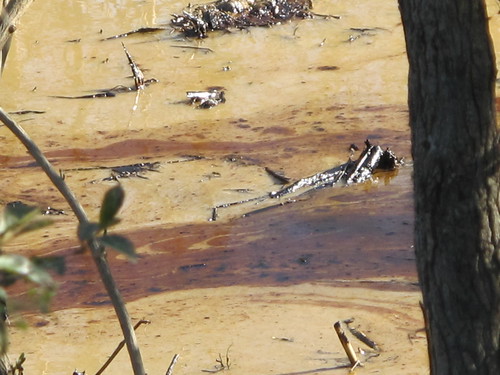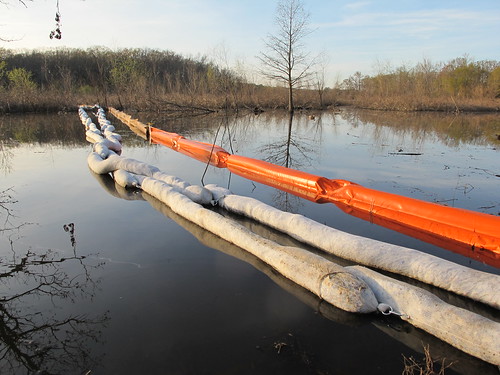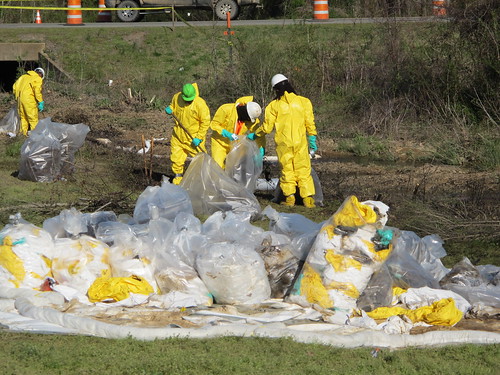A River of Tar Sands Crude Floods an Arkansas Town
Amber Bartlett had just finished reading a book in her Mayflower, AR, home when she got a call from her teenage daughter that she will never forget; police had stopped her from entering their subdivision because of a dangerous oil spill in the neighborhood. Amber looked out her window in disbelief, but there it was, a river of thick, black noxious crude oil gushing down the street near her driveway, forming little waves as it lapped over the sewer drain.
Amber's family and 20 other homes were evacuated as the result of a major blowout along ExxonMobil’s Pegasus pipeline, which pushes up to 90,000 barrels of heavy Canadian tar sands crude from terminals in Illinois to refineries in Texas. Officials estimate the spill released more than 200,000 gallons of the thick tar sands oil from Alberta, Canada—referred to by Exxon as Wabasca Heavy crude but considered tar sands by authorities in Canada. The carbon-rich oil is mixed with chemical additives called diluents to flow though pipelines.
Check out this video about the ExxonMobil tar sands pipeline spill in Mayflower, AR.
http://www.youtube.com/watch?v=HZDUhN_7YjQ&feature=share&list=UUNia_X3a7HLxBSN-z57UGQw
The tarry oil poured out into yards and driveways near a break in the pipe behind the town’s Northwoods subdivision, then flowed down though culverts and streams by the town shopping center near a Subway shop and Dollar General, oozing under the highway into a marshy cove that feeds into Lake Conway, a prized fishing spot in Arkansas. Amber and many residents were completely caught off-guard by this oily assault that suddenly rose out of the earth like a bad horror movie.
“I had no idea there was a pipeline near where I live so I would never in a million years thought I would have had to evacuate due to the oil spill… it’s made me extremely thankful that our children were not out there playing and that all of them are safe, because right where it busted our children play there every day.”
The Pegasus pipeline break fractured the tranquility of this tiny rural community, filling the small streets, shopping areas and highway access roads with heavy machinery, vacuum trucks and men in hard hats and hazmat suits mopping up the oily goop that invaded the town like a black plague. Fishing season is just getting underway in Lake Conway, but the yellow booms that stretch out into the calm waters present an ominous sign that something isn’t quite normal in this picture-postcard community.


Thick tar sands oil from ExxonMobil's pipeline flows through Mayflower last week.
Photos: Rocky Kistner/NRDC
And it's not hard to find the culprit. InsideClimate News’ Lisa Song, part of a Pulitzer Prize-winning team for its investigation into the hazards surrounding Enbridge's record tar sands pipeline spill in the Kalamazoo River, reported that the Mayflower rupture caused a massive 22-foot gash in the pipe, three times the size of the one in Michigan. Since pipelines operate under enormous pressures, a crack in pipelines like these can cause catastrophic failure, as Song reported here;
"People just don't gather how high these things can go," said Richard Kuprewicz, president of the pipeline consulting firm Accufacts Inc. "For the average person, they're just exotic pressures." But if pipeline operators drop their guard, he said, pipelines "can be highly destructive."
What caused the disaster in Mayflower is under investigation, and it’s unknown how long Exxon’s Pegasus pipeline will be shut down. It’s also unclear how long cleanup operations will take, both in the immediate neighborhoods where the oil flowed through, as well as the marshy cove where much of it ended up. ExxonMobil has promised to cover all legitimate claims for local residents, but no one knows exactly what that means or when people will move back into their homes.


Oil cleanup work in the Northwoods subdivision Photos: Rocky Kistner/NRDC
Some locals fear the impacts will be long term. That’s what Mayflower resident Cameron Thompson believes, and he says he should know since he has an environmental background and works for the oil and gas industry. He lives about a mile from the pipeline spill and says he had no idea there was an oil pipeline running through the community. He and his wife have been trying to sell their five-acre property, but now he says that’s a lost cause.
"The property values around here is destroyed because that pipeline runs straight all the way through here….I feel sorry for everybody. There’s lots of people that spent their hard-earned time and their money on buying places and building houses and they won’t ever recover that."
And many residents are concerned about their health and well-being. Sherry Appleman and her husband have lived along Lake Conway in their dream house for the past dozen years, enjoying the idyllic fishing and wildlife environment until their lives suddenly were turned upside down after the spill. Sherry says they both have been sick, and she hasn’t been able to get adequate information about potential health and wildlife impacts. She doesn’t trust assurances from Exxon or government officials that the air and water are safe.
I fell asleep with my bedroom window open, woke up in the middle of night because couldn’t breathe and was up the rest of the night because was trying to catch my breath and immediately close the window. Then went to check on my husband because my husband has lung cancer he was just diagnosed in January. He was extremely ill and has been ever since this started…I think Exxon should do everything to make everybody in this community whole to the best of their ability. I think they should be held accountable by the government and by the public. But I don’t see that happening anytime soon.


Booms and oil cleanup bags in Mayflower Photos: Rocky Kistner/NRDC
The ExxonMobil gusher has made many residents painfully aware of the hazards of oil pipelines, especially those that carry toxic tar sands oil from the boreal forests of Alberta through communities like Mayflower and to massive chemical refineries in the Gulf. That’s true for Northwoods resident Chris Harrell, who lives only a block away from the Pegasus pipeline break. Like many, he wonders what long-term health problems his family may develop or how they will be compensated.
“We’re frustrated, exhausted and overwhelmed and tired of messing with this…there’s been so little solid information about what will happen. Exxon has not been forthcoming about what kind of timeframes we are dealing with, whether it’s two months or two years.”
But the steady stream of oil that flowed though his community has made him think about our country’s dependency on fossil fuels, especially with President Obama’s looming decision whether to permit the Keystone XL tar sands pipeline to cross the Canadian border and carry tar sands oil all the way to the Gulf. Chris says he would much rather see money be invested in developing alternative clean energy sources than spent on building more pipelines. After this experience, he says, “tar sands oil is terrifying to me.”
For anyone who witnessed the Easter weekend flood of tar sands crude in Mayflower, that’s very easy to understand.
